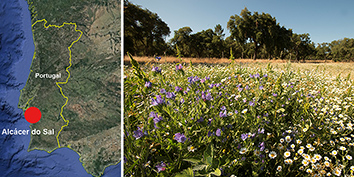Volume 7, Issue 3 (2021)
J. Insect Biodivers. Syst 2021, 7(3): 251-261 |
Back to browse issues page
Download citation:
BibTeX | RIS | EndNote | Medlars | ProCite | Reference Manager | RefWorks
Send citation to:



BibTeX | RIS | EndNote | Medlars | ProCite | Reference Manager | RefWorks
Send citation to:
Miranda-Barroso L, Aguado O, Vicente Falcó-Gari J, Lopez D, Schade M, Vasileiadis V et al . Multifunctional areas as a tool to enhance biodiversity and promote conservation in alfalfa fields. J. Insect Biodivers. Syst 2021; 7 (3) :251-261
URL: http://jibs.modares.ac.ir/article-36-51093-en.html
URL: http://jibs.modares.ac.ir/article-36-51093-en.html
Luis Miranda-Barroso1 
 , Oscar Aguado2
, Oscar Aguado2 
 , José Vicente Falcó-Gari3
, José Vicente Falcó-Gari3 
 , David Lopez3
, David Lopez3 
 , Michael Schade4
, Michael Schade4 
 , Vasileios Vasileiadis4
, Vasileios Vasileiadis4 
 , Francisco Javier Peris Felipo *
, Francisco Javier Peris Felipo * 
 5
5

 , Oscar Aguado2
, Oscar Aguado2 
 , José Vicente Falcó-Gari3
, José Vicente Falcó-Gari3 
 , David Lopez3
, David Lopez3 
 , Michael Schade4
, Michael Schade4 
 , Vasileios Vasileiadis4
, Vasileios Vasileiadis4 
 , Francisco Javier Peris Felipo *
, Francisco Javier Peris Felipo * 
 5
5
1- Agricultura Sostenible Syngenta España – c/. de la Ribera del Loira, 8, 10 – 28042 – Madrid – Spain
2- Andrena Iniciativas y Estudios Medioambientales S.L. – c/. Gabilondo 16bis – 47007 Valladolid – Spain
3- Laboratory of Entomology and Pest Control – Institute Cavanilles of Biodiversity and Evolutionary Biology – c/ Catedrático José Beltrán 2 – 46980 – Paterna – Valencia – Spain
4- Syngenta Crop Protection – Rosentalstrasse 67 – 4058 – Basel – Switzerland
5- Syngenta Crop Protection – Rosentalstrasse 67 – 4058 – Basel – Switzerland , peris.felipo@gmail.com
2- Andrena Iniciativas y Estudios Medioambientales S.L. – c/. Gabilondo 16bis – 47007 Valladolid – Spain
3- Laboratory of Entomology and Pest Control – Institute Cavanilles of Biodiversity and Evolutionary Biology – c/ Catedrático José Beltrán 2 – 46980 – Paterna – Valencia – Spain
4- Syngenta Crop Protection – Rosentalstrasse 67 – 4058 – Basel – Switzerland
5- Syngenta Crop Protection – Rosentalstrasse 67 – 4058 – Basel – Switzerland , peris.felipo@gmail.com
Abstract: (1365 Views)
The present study analyses the effects of multifunctional areas (MA) for three years (2013–2015) on an intensive multi-crop farm in Portugal. The implementation of MA resulted in a wide range of enhancements in the insect community, such as significant effects as a reservoir, allowing an increase of 102.47% in the number of species and 97.64% of individuals. MA play an important role in conservation strategies and help increase the population of rare and threatened arthropod species.
Article Type: Research Article |
Subject:
Biodiversity/Other taxa
Received: 2021/03/22 | Accepted: 2021/04/9 | Published: 2021/04/15
Received: 2021/03/22 | Accepted: 2021/04/9 | Published: 2021/04/15
References
1. Aguado, L.O., Viñuelas, E. & Ferreres, A. (2016) Guía de polinizadores de la península ibérica y de los archipiélagos balear y canario. Ediciones Mundiprensa & Syngenta, Madrid, Spain, 364 pp.
2. Albrecht, M., Kleijn, D., Williams, N., Tschumi, M., Blaauw, B., Bommarco, R., Campbell, A., Dainese, M., Drummond, F., Entling, M., Ganser, D., De Groot, A., Goulson, D., Grab, H., Hamilton, H., Herzog, F., Isaacs, R., Jacot, K., Jeanneret, F., Jonsson, M., Knop, E., Kremen, C., Landis, D., Loeb, G., Marini, L., McKerchar, M., Morandin, L., Pfister, S., Potts, S., Rundlöf, M., Sardiñas, H., Sciligo, A., Thies, C., Tscharntke, T., Venturini, E., Veromann, E., Vollhardt, I., Wäckers, F., Ward, K., Wilby, A., Woltz, M., Wratten, S., Sutter, L. (2020) Global synthesis of the effectiveness of flowers strips and hedgerows on pest control, pollination services and crop yield. Ecology Letters, 23, 1488–1498. [https://doi.org/10.1111/ele.13576]
3. Amy, C., Noël, G., Hatt, S., Uyttenbroeck, R., Van de Meutter, F., Genoud, D. & Francis, F. (2018) Flower strips in wheat intercropping system: effect on pollinator abundance and diversity in Belgium. Insects, 9 (3), 114. [https://doi.org/10.3390/insects9030114]
4. Bauer, S., Chapman, J.W., Reynolds, D.R., Alves, J.A., Dokter, A.M., Menz, M.M.H., Sapir, N., Ciach, M., Pettersson, L.B., Kelly, J.F., Leijnse, H. & Shamoun-Baranes, J. (2017) From agricultural benefits to aviation safety: realizing the potential of continent-wide radar networks. Bioscience, 67, 912–918. [https://doi.org/10.1093/biosci/bix074]
5. Brown, M.J.F. & Paxton, R.J. (2009) The conservation of bees: A global perspective. Apidologie, 40, 410–416. [https://doi.org/10.1051/apido/2009019]
6. Brussaard, L., De Ruiter, P.C. & Brown, G.G. (2007) Soil biodiversity for agricultural sustainability. Agriculture, Ecosystems and Environment, 121, 233–244. [https://doi.org/10.1016/j.agee.2006.12.013]
7. Castle, D., Grass, I. & Westphal, C. (2019) Fruit quantity of strawberries benefit from enhanced pollinator abundance at hedgerows in agricultural landscapes. Agriculture, Ecosystems and Environment, 275, 14–22. [https://doi.org/10.1016/j.agee.2019.01.003]
8. De Snoo, G.R. (1999) Unsprayed field margins: effects on environment, biodiversity and agricultural practice. Landscape and Urban Planning, 46, 151–160. [https://doi.org/10.1016/S0169-2046(99)00039-0]
9. Dudley, N. & Alexander, S. (2017) Agriculture and biodiversity: a review. Biodiversity, 18 (2–3), 45–49. [https://doi.org/10.1080/14888386.2017.1351892]
10. Erisman, J.W., van Eekeren, N., de wit, J., Koopmans, C., Cuijpers, W., Oerlemans, N. & Koks, B.J. (2016) Agriculture and biodiversity: a better balance benefits both. Journal of Agriculture and Food, 1 (2), 157–174. [https://doi.org/10.3934/agrfood.2016.2.157]
11. Foley, J.A., Ramankutty, N., Brauman, K.A. Cassidy, E.S., Gerber, J.S., Johnston, M., Mueller, N.D., O'Connell, C., Ray, D.K., West, P.C., Balzer, C., Bennett, E.M., Carpenter, S.R. Hill, J., Monfreda, C., Polasky, S., Rockström, J., Sheehan, J., Siebert, S., Tilman, D., Zaks, D.P.M. (2011) Solutions for a cultivated planet. Nature, 478, 337–342. [https://doi.org/10.1038/nature10452]
12. Haddaway, N.R., Brown, C., Eggers, S., Josefsson, J., Kronvang, B., Randall, N. & Uusi-Kämppä, J. (2016) The multifunctional roles of vegetated strips around and within agricultural fields. A systematic map protocol. Environmental Evidence, 5, 18. [https://doi.org/10.1186/s13750-016-0067-6]
13. Hammer, O., Harper, D. & Ryan, P. (2001) PAST: Paleontological Statistics Software for education and data analysis. Paleontologia Electronica, 4, 1–9.
14. Hannon, L.E. & Sisk, T.D. (2009) Hedgerows in an agri-natural landscape: Potential habitat value for native bees. Biological Conservation, 142, 2140–2154. [https://doi.org/10.1016/j.biocon.2009.04.014]
15. Holden, J., Grayson, R.P., Berdeni, D., Bird, S., Chapman, P.J., Edmondson, J.L., Firbank, L.G., Helgason, T., Hodosn, M.E., Hunt, S.F.P., Jones, D.T., Lappage, M.G., Marshall-Harries, E., Nelson, M., Prendergast-Miller, M., Shaw., H., Wade, R.N. & Leake, J.R. (2019) The role of hedgerows in soil functioning within agricultural landscapes. Agriculture, Ecosystems and Environment, 273, 1–12. [https://doi.org/10.1016/j.agee.2018.11.027]
16. Holland, J. & Fahrig, L. (2000) Effect of woody borders on insect density and diversity in crop fields: a landscape-scale analysis. Agriculture, Ecosystems and Environment, 78, 115–122. [https://doi.org/10.1016/S0167-8809(99)00123-1]
17. Holland, J.M., Bianchi, F.J.J.A., Entling, M.H., Moonen, A.C., Smith, B.M. & Jeanneret, P. (2016) Structure, function and management of semi-natural habitats for conservation biological control: A review of European studies. Pest Management Science, 72, 1638–1651. [https://doi.org/10.1002/ps.4318]
18. IUCN (2020) The International :union: for Conservation of Nature (IUCN) Red List of Threatened Species. Version 2020-1. Available from: https://www.iucnredlist.org/ [Accessed 8th October 2020].
19. IPMA (2020) Portuguese Institute for Sea and Atmosphere. Available from: https://www.ipma.pt/ [Accessed 10th December 2020].
20. Jacot, K., Eggenschwiler, L., Junge, X., Luka, H. & Bosshard, A. (2007) Improved field margins for a higher biodiversity in agricultural landscapes. Aspects of Applied Biology, 87, 277–283.
21. Jiménez-Peydró, R. & Peris-Felipo, F.J. (2014) Diversity and community structure of Opiinae (Hymenoptera, Braconidae) in Mediterranean landscapes of Spain. Journal of Entomological Research Society, 16 (3), 75–85.
22. Kremen, C., Albrech, M. & Ponisio, L.C. (2019) Restoring pollinator communities and pollination services in hedgerows in intensively managed agricultural landscapes. In: Dover, J.W. (ed.) The Ecology of Hedgerows and Field Margins, Routledge, London, UK, pp. 163–185.
23. Magurran, A.E. (1991) Ecological Diversity and its Measurement. Princeton University Press, Princeton. 178 pp.
24. Marshall, E.J.P. & Moonen, A.C. (2002) Field margins in northern Europe: their functions and interactions with agriculture. Agriculture, Ecosystems and Environment, 89, 5–21. [https://doi.org/10.1016/S0167-8809(01)00315-2]
25. Marshall, E.J.P. & Nowakowski, M. (1995) Successional changes in the flora of a sown field margin strip managed by cutting and herbicide application. Brighton Crop Protection Conference - Weeds, British Crop Protection Council, Farnham, Surrey, pp. 973–978.
26. Meek, B., Loxton, D., Sparks, T., Pywell, R., Pickett, H. & Nowakowski, M. (2002) The effect of arable field margin composition on invertebrate biodiversity. Biological Conservation, 106, 259–271. [https://doi.org/10.1016/S0006-3207(01)00252-X]
27. Morandin, L.A. & Kremen, C. (2013) Hedgerow restoration promotes pollinator populations and exports native bees to adjacent fields. Ecological Applications, 23, 829–839. [https://doi.org/10.1890/12-1051.1]
28. Moreno, C. (2001) Métodos para medir la Biodiversidad. Sociedad Entomológica Aragonesa, Zaragoza, Spain. 84 pp [in Spanish].
29. Myers, N., Mittermeier, R.A., Mittermeier, C.G., Fonseca, G.A.B. & Kent, J. (2000) Biodiversity hotspots for conservation priorities. Nature, 403, 853–858. [https://doi.org/10.1038/35002501]
30. New, T.R. (2005) Invertebrate Conservation in Agricultural Ecosystems. Cambridge University Press, Cambridge, UK, 396 pp. [https://doi.org/10.1017/CBO9780511542114]
31. Nowakowski, M. & Pywell, R. (2016) Habitat Creation and Management for Pollinators. Centre for Ecology & Hydrology, Wallingford, UK, 92 pp.
32. Paoletti, M.G., Boscolo, P. & Sommaggio, D. (1997). Beneficial insects in field surrounded by hedgerows in North Eastern Italy. Biological Agriculture & Horticulture, 15 (4), 310–323. [https://doi.org/10.1080/01448765.1997.9755206]
33. Pungetti, G. (2003) Diseño ecológico del paisaje. Planificación y conectividad en el mediterráneo y en Italia. In: García-Mora, M.R. (ed.) Conectividad Ambiental: Las Areas Protegidas en la Cuenca Mediterránea. Junta de Andalucía, Spain, pp. 111–124 [in Spanish].
34. Roy, D.B., Bohan, D.A., Haughton, A.J., Hill, M.O., Osborne, J.L., Clark, S.J., Perry, J.N., Rothery, P., Scott, R.J., Brooks, D.R., Champion, G.T., Hawes, C., Heards, M.S. & Firbank, L.G. (2003) Invertebrates and vegetation of field margins adjacent to crops subject to contrasting herbicide regimes in the Farm Scale Evaluations of genetically modified herbicide-tolerant crops. Philosophical Transactions of the Royal Society B, 358, 1879–1898. [https://doi.org/10.1098/rstb.2003.1404]
35. Schumacher, W. (1984) Gefährdete Ackerwildkräuter können auf ungespritzten Feldrändern erhalten werden. Mitteilungen LÖLF, 9 (1), 14–20.
36. Smith, J., Potts, S.G., Woodcock, B.A. & Eggleton, P. (2008) Can arable field margins be managed to enhance their biodiversity, conservation and functional value for soil macrofauna? Journal of Applied Ecology, 45, 269–278. [https://doi.org/10.1111/j.1365-2664.2007.01433.x]
37. Tschumi, M., Albrecht, M., Entling, M.H. & Jacot, K. (2015) High effectiveness of tailored flower strips in reducing pests and crop plant damage. Proceedings of the Royal Society B, 282, 20151369. [https://doi.org/10.1098/rspb.2015.1369]
38. van Rijn, P.C.J. & Wächers, F.L. (2016) Nectar accessibility determines fitness, flower choice and abundance of hoverflies that provide natural pest control. Journal of Applied of Ecology, 53 (3), 925–933. [https://doi.org/10.1111/1365-2664.12605]
39. Villarreal, H., Alvarez, H.M., Córdoba, S., Escobar, F., Fagua, G., Gast, F., Mendoza, H., Ospina, M. & Umaña, A.M. (2004) Insectos. In: Álvarez, M., Córdoba, S., Escobar, F., Fagua, G., Gast, F., Mendoza, H., Ospina, M. & Umaña, A.M. (eds.) Manual de métodos para el desarrollo de inventarios de biodiversidad. Instituto de Investigación de Recursos Biológicos Alexander von Humboldt, Bogotá, Colombia, pp. 149–169 [in Spanish].
Send email to the article author
| Rights and permissions | |
 |
This work is licensed under a Creative Commons Attribution-NonCommercial 4.0 International License. |








